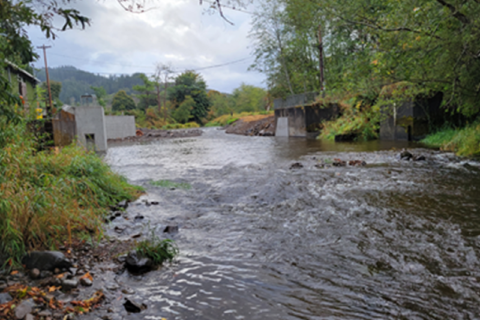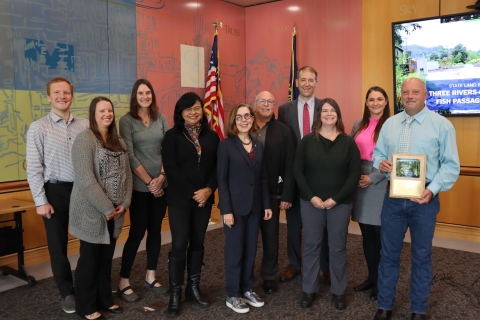This week, U.S. Fish and Wildlife Service staff were part of a team recognized by the Oregon State Land Board for the Three Rivers Fish Passage Restoration Project, funded in part by the Columbia River Fish and Wildlife Conservation Office National Fish Passage Program. This project highlights one of the first fully compliant fish ladders for adult Pacific lamprey, an anadromous fish native to the Pacific Northwest.
Designed and overseen by Oregon Department of Fish and Wildlife engineering staff, the Service contributed funding, technical and species expertise and permitting compliance. The team is hopeful that this collaboration will increase the attention to the unique Pacific lamprey passage needs in future passage projects in the region.
Located at Oregon Department of Fish and Wildlife’s Cedar Creek Hatchery, the nearly $2.5 millionproject resulted in 14 miles of upstream passage for federally listed coho and three species of concern — winter steelhead, Pacific lamprey and coastal cutthroat trout.
News Release from the Oregon Department of State Lands Newsroom:
Three Rivers-Cedar Creek Hatchery Fish Passage Restoration Recognized with State Land Board Award
October 11, 2022
SALEM, Ore. — An innovative project that removed a major barrier to fish migration on Oregon’s North Coast was honored today by the State Land Board during the 18th Annual State Land Board Awards.
Governor Kate Brown, Treasurer Tobias Read, and Secretary of State Shemia Fagan recognized the Three Rivers-Cedar Creek Hatchery Fish Passage Restoration Project, which opened access to habitat for the threatened Oregon Coast Coho Salmon and other species as part of the Salmon SuperHwy partnership.
“Thanks to this team’s efforts to restore fish passageways, young salmon and other fish species can speed along 14 more miles on their journey to the Pacific Ocean,” said State Treasurer Tobias Read, who presented the award.
The Salmon SuperHwy is a unique community partnership seeking to restore access to nearly 180 miles of blocked habitat throughout six coastal rivers. Removing barriers to fish passage fish passage
Fish passage is the ability of fish or other aquatic species to move freely throughout their life to find food, reproduce, and complete their natural migration cycles. Millions of barriers to fish passage across the country are fragmenting habitat and leading to species declines. The U.S. Fish and Wildlife Service's National Fish Passage Program is working to reconnect watersheds to benefit both wildlife and people.
Learn more about fish passage through the Three Rivers tributary at Cedar Creek Hatchery was a high priority.
“The Three Rivers project is an excellent example of how Salmon SuperHwy partners work together to improve fish passage for migratory fish,” said Sarah Zwissler, Salmon SuperHwy Coordinator. “The Oregon Department of Fish and Wildlife led the project, while local, state, and federal Salmon SuperHwy partners supported the project with funding, technical resources, and outreach to restore access to 14 stream miles of upstream habitat for salmonids and lamprey.”
A weir barrier crossed the full width of Three Rivers, with concrete abutments on both banks. The barrier, which facilitated collection of hatchery brood stock, was at a maximum height of nine feet for most of the year, impeding fish passage.
But ODFW engineers found a solution. The existing weir was replaced with an inflatable weir and a functional fish ladder and passage facilities. The fish ladder was specifically designed to provide continuous year-round passage for species-of-concern such as Pacific lamprey, juvenile 2 salmonids and smaller cutthroat, while detaining adult salmon to allow manual sorting of hatchery fish.
The Salmon SuperHwy partnership is aiming to complete 93 access restoration projects in just 10 years. With 115 miles reconnected to-date, salmon are well on their way.
The Land Board Awards honor exceptional projects and partners for their contributions to protecting and enhancing Oregon’s treasured natural resources. View the awards ceremony on the Department of State Lands YouTube Channel. ###
About the State Land Board
The State Land Board consists of Governor Kate Brown, Secretary of State Shemia Fagan and State Treasurer Tobias Read. Established by the Oregon Constitution in 1859, the Land Board oversees the state’s Common School Fund.
About the Department of State Lands
The Department of State Lands is the Land Board’s administrative agency, managing the lands and resources that help fund Oregon’s public schools and protecting the state’s waterways and wetlands for the many benefits they provide. For more information on DSL, visit www.oregon.gov/DSL.








